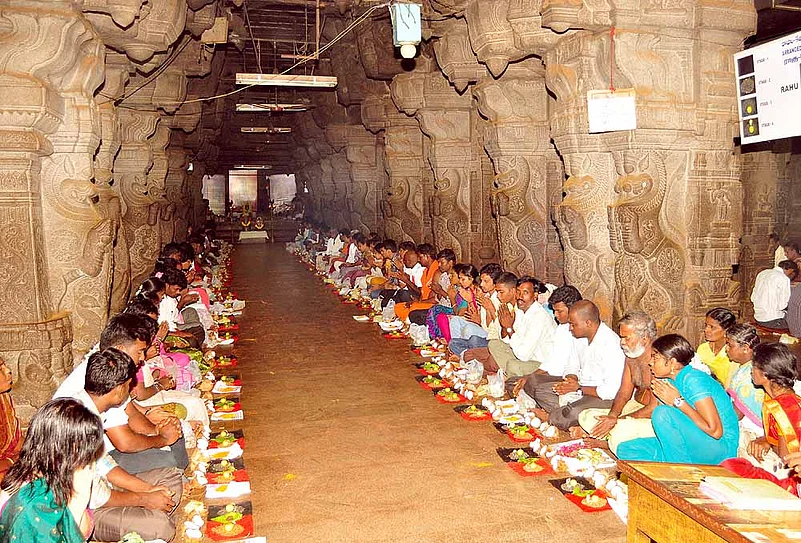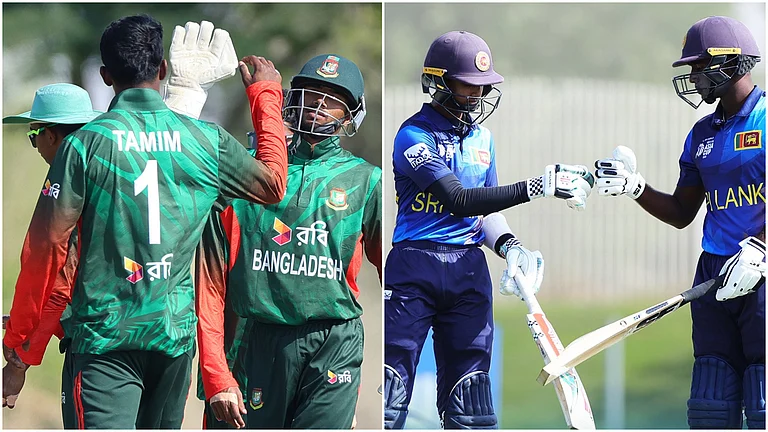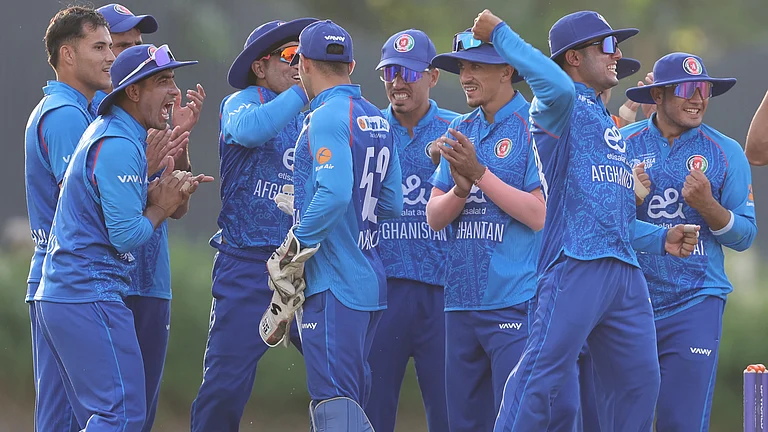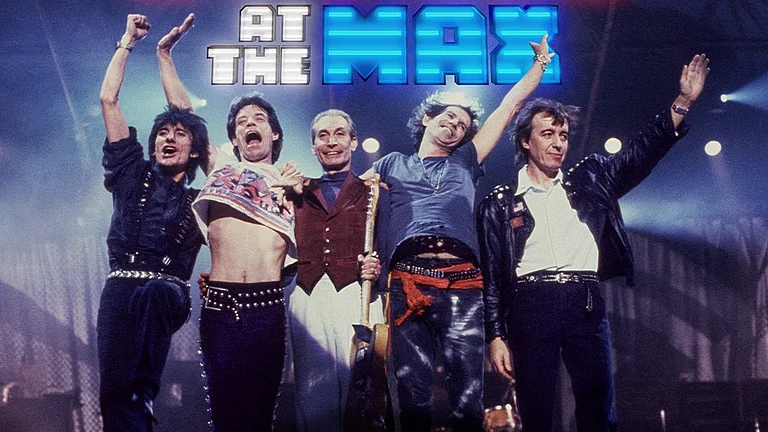Their shaven heads glistening in the light of dawn, devotees with the signature Tirupati ‘look’ queue up next for a complementary darshan at the Shiva Kalahasteeswara temple in Srikalahasti. For many, there is impeccable celestial logic in sequencing their prayers thus: first the lord on the hill, and then the one an hour’s drive away. Hair shorn in votive offering to Balaji, a form of Vishnu, at Tirupati, they reach Srikalahasti to propitiate Shiva and perform a Rahu-Ketu puja to remove hurdles in their path and attract positive changes in their lives—all within three months.
To those who abide by the definitions of astrology, Rahu and Ketu are rakshasa grahas, and their presence in one’s horoscope can throw steep challenges to achieving one’s life goals, which run the gamut of the mundane—marriage, a house of one’s own, a job, or a child. Seeking Shiva’s divine intervention to dispel that malign influence from their lives, around 10,000 people queue up daily at the Srikalahasti temple, their donations totting up Rs 60 crore (unofficially, Rs 100-odd crore) each year. This might be modest compared to the draw and the collection at Tirupati; nevertheless, there’s no dearth of faith. The tickets for the Rahu-Ketu puja (costs go from Rs 300 to Rs 2,500) vanish within hours of the shrine opening at dawn.
Brothers Praveen and Chandrasekhar Reddy, both software engineers, always head straight for Srikalahasti after their annual trip to Tirupati. Praveen, who sports the shorn look, says whenever he wishes for something at Srikalahasti and it is fulfilled, he makes sure that he makes a comeback trip, a thanksgiving.

The lord of handicrafts Kalamkari, a key part of Srikalahasti’s cultural universe. (Photograph by K.R. Vinayan)
Topping the wish list of most devotees is marriage or the begetting of children, events that astrologers have told them have been held up by Rahu and Ketu. Singletons looking for the right match, parents with sons and daughters of marriageable age, childless couples—all of them arrive here in pious hope. There are those too who turn up here with career on their minds, or maybe parents with teenaged children who believe the puja will launch them on a successful orbit. Of the latter ilk, Tejaswini, an 18-year-old engineering student, says she does not believe in the lore associated with the temple but has come on her parents’ request. Nadiya Venkatesh, a 23-year-old from Tiruppur, Tamil Nadu, who is accompanying her parents for the Rahu-Ketu puja, flashes a dimpled smile and says the puja worked for her elder sister, so of course she wants to perform it too.
The rituals continue through the day, till 7 pm, when the last lot of devotees emerge after the pujas, bearing tiny silver sarpas (figurines of snakes) to deposit them in the temple hundis. The snake figurines are taken to the Cherlapally mint in Hyderabad, where they are melted into bars. “The melting of the sarpas is the last stage, in which devotees’ sins are purged,” says Ramachandra Murthy, an executive officer at the temple. He grabs a notebook and pen and draws up a classic case of a sarpa dosha chart, a horoscope in which all the planets fall between Rahu and Ketu, supposedly making life a rough ride. Drawn up, the horoscope looks like a snake’s hood, giving it the name.
This town of some 80,000, in south Andhra’s Chittoor district, has a mixed population of Tamil and Telugu speakers—all rituals are conducted in both languages. For those sitting down for a Rahu-Ketu puja but possessing neither language, it’s easy enough to nudge your neighbour for instructions or to do exactly as they do. You just don’t want to do it wrong, having come all the way. The temple officials are bilingual though it’s natural in these parts for locals to launch into Tamil first.
Veera Mani, a temple employee, says it’s not just the aam aadmi—politicians, film stars, bureaucrats from both states are frequent visitors. Mani belongs to the mercantile Chettiar community of Tamil Nadu, which played an important role in renovating and restoring this temple in the 19th century. “People get important posts if they visit the Srikalahasti temple. Pranab Mukherjee came visiting and became president, Jayalalitha became chief minister and Justice P. Sathasivam became chief justice,” he says.
The true pull of the place, nevertheless, owes to common folk—driven sometimes by hope against all hope, sometimes by gratitude, for past fulfilment of wishes. Srikalahasti’s catchment area too may not be as national in scope as Tirupati’s but is by no means modest: besides states in the region, pilgrims come from Maharashtra and beyond. Sakshi and Prakash, a young couple from Sholapur, say they were able to get married, buy a small house, and Prakash could land a job as a bank executive—all because of the blessings of Lord Shiva. “And this time, we’re praying for a child.”
Prof D. Kirankranth Choudary, principal at the S.V. University, Tirupati, who finished a PhD on the Srikalahasti temple in 1979, differentiates the faddish from the traditional. He says the belief about Srikalahasti being a Rahu-Ketu kshetra, or zone, was born only in the mid-’80s and ’90s. On the other hand, as his studies revealed to him, the temple is a repository of great cultural wealth. He found 219 inscriptions in Tamil, Kannada, Telugu and Sanskrit here. “The earlier inscriptions were in Tamil, the other languages were added later. This proves trilingual practices were prevalent during the Vijayanagara empire,” he says.
Indeed, Tamil classical literature too makes frequent references to the Srikalahasti temple. “One of the earliest inscriptions here is of Raja Raja Chola, and can be dated to 1001 AD,” says the professor. Talking of the swayambhu, or sui generis, Shivalinga here, he says it’s a fossilised idol and not one of stone. Legend has it that anyone daring to touch the idol will die in a few days. To this day, priests do not touch the main linga even during puja.

Photograph by K.R. Vinayan
There’s a serenity to the place, but of a fragile sort, as is sadly always the case in India’s temple towns. The 14-km-long Kailasagiri hills fringing it on the west lend it a sense of grandeur and space: the chants of ‘Om Namah Shivaya’ seem to fairly echo off the mountains back into town. Compared to Tirupati, there’s hardly any shoving and nudging here either—except on Mahashivaratri and such occasions. But on either flank of the Swarnamukhi, whose eastern bank the temple is located on, there are a dozen lodges—all of which send their sewage right into the river. Plastic litter abounds. Taking a walk along the streets close to the temple, the quietude is rudely interrupted every few steps as lodge-keepers yell out, “Room?”.... Or when ash-smeared sadhus accost you for alms. Or when auto-drivers insist on showing you around town, the price you strike depending only on your bargaining abilities.
There are 40-odd lodges and guesthouses in Srikalahasti, each promising high levels of comfort. Some even offer to arrange for special darshan and puja tickets. At one such lodge, endearingly named Philligrims Residency, the many bonuses seem to outdo the size of the matchbox-sized rooms. As with any other temple town, locals view tourists with a weariness that comes from years of answering repetitive questions such as, “Do wishes really come true within three months of the Rahu-Ketu pujas?”
At the municipal primary school of Purapalaka Sangha Prathamika Pathashala, there are 76 children studying in Class I to V. The students, mostly children of farm coolies and labourers, tell this correspondent that they love taking a shortcut through the temple from school to home. Out of the eight Class V students, not one is able to spell Srikalahasti. But then, when only three teachers teach all the subjects in the school, the reason is not hard to guess.
The pilgrim’s eye, fixed on the personal, may miss the grand historical stream of art here, and it may miss the element of craft that elevates traditional India’s spaces. Srikalahasti’s yen is for Kalamkari. A bamboo pen dipped in natural dye is used to sketch beautiful paintings, mostly of dieties and scenes from the Mahabharata, Ramayana and the Puranas. A trip to the town’s outskirts, to the Bhanodaya Kalamkari Institute in Vidya Prakash Nanda Nagar, is well worth your time, once the wish fulfilment pujas are done. P. Padmavathi, 32, who runs the centre with 20 artisans, bustles around with her pug Snoopy following loyally. She introduces Ramachandraiah, who’s been sketching deities for 30 years. His fingers move with dexterity as Snoopy sniffs at the dye made of alum, kathai leaves, kaduka seeds, buffalo milk, turmeric and flowers. It’s popular on saris, wall hangings and bedsheets but was originally meant for temple scrolls and decoration and chariot banners.
Padmavathi says she feels blessed to be living in this town. “I make several trips to the temple but my wish is always the same. That I am able to put in hard work into my passion, Kalamkari, and that I am patient enough to wait for the results,” she says. The material for some, the abstract for others—it’s all down to the Lord of Srikalahasti.


























